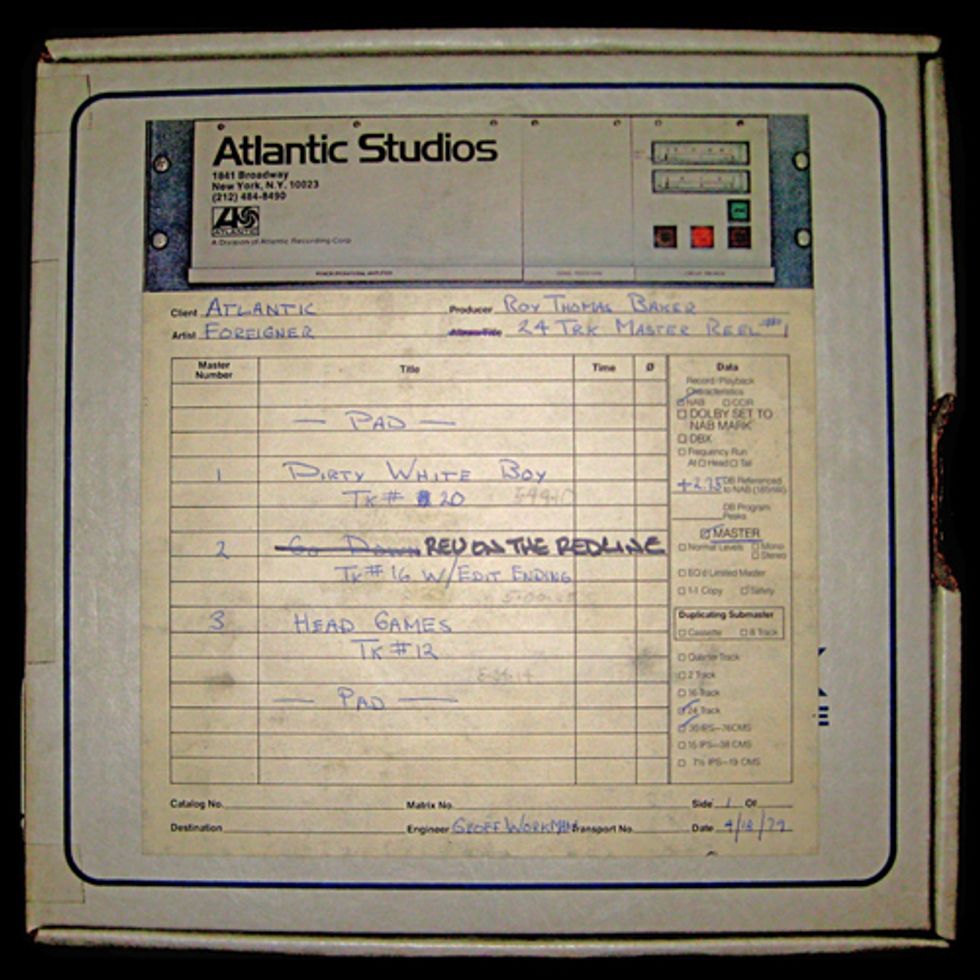Foreigner''s "Dirty White Boy" master tracks reveal a state-of-the-art late-''70s recording process
| The sound engineers at OEM Inc. have spent thousands of hours with the original masters of the most famous songs ever recorded. They use them to create products like Jammit, an iPhone app that allows you to remix and play along with those original tracks. There are many, many things to learn from those original tracks. Through a partnership with Gearhead Communications, OEM Inc. engineers are sharing their discoveries exclusively with Premier Guitar readers in what we like to call Secrets of the Masters |
 I consider it a privilege just to be able to hear the raw multi tracks of some of rock ’n’ roll’s most famous recordings, so being a part of the OEM team that recreates these classic mixes for use in the Jammit iPhone app is beyond exhilarating. “Dirty White Boy” is one of three songs featured in the Jammit: Classic Rock Vol. 1 app for the iPhone (along with Deep Purple’s “Smoke on the Water” and Alice Cooper’s “I’m Eighteen”) and I thought it would be worth relaying some of the thoughts I had while working with the multi-tracks of this historic recording.
I consider it a privilege just to be able to hear the raw multi tracks of some of rock ’n’ roll’s most famous recordings, so being a part of the OEM team that recreates these classic mixes for use in the Jammit iPhone app is beyond exhilarating. “Dirty White Boy” is one of three songs featured in the Jammit: Classic Rock Vol. 1 app for the iPhone (along with Deep Purple’s “Smoke on the Water” and Alice Cooper’s “I’m Eighteen”) and I thought it would be worth relaying some of the thoughts I had while working with the multi-tracks of this historic recording.
History
This SMPTE-synced, 48-track session (using both master and slave 2” analog tapes) would have been state of the art in the spring of 1979. With Roy Thomas Baker (Queen, Journey) at the helm, who was legendary even then, “Dirty White Boy” not only kicked off Foreigner’s classic 1979 record Head Games, but was the album’s biggest hit, peaking at #12 on the Billboard singles chart. Geoff Workman engineered this song at Atlantic Records Studios in New York City. He went on to record with bands like Twisted Sister and Mötley Crüe—acts known for the kind of raw, biting mid-range presence that exists in this Foreigner song. For the time, this was certainly a departure from the typically round, fat tones of the disco era that was simultaneously gasping its last breaths.
Sonic Evaluation
 The box of the original "Dirty White Boy" reel. Click here to see a larger image. |
Missing in Action
It’s always interesting to hear outtakes or tracks that were muted and consequently not included into the final mix that we’re all accustomed to hearing. This Foreigner song has several lead guitar moments that, for whatever reason, did not go the distance. Mick Jones had several Jimmy Page-like moments that were momentarily muted on the console during the final mix—this is clear because they shared a track with the solo and other lead lines that did make their way into music history. There were also ten bars, a revolution of an additional end chorus, that were edited out of the final arrangement. This would have occurred via tape edit on the final 2-track master.
Re-Creation Story
What a difference a few decades makes. Like many ’70s-era mixes, “Dirty White Boy” basically sounds like the sum of its parts. The raw, unmixed tracks already resemble the sound of the final original mix. Would we love this song any more or less had Jones’ Jimmy Page-like moments made the final cut? Would this song have sounded the same if the band and the production team had different technology back then? Though interesting to think about, those questions aren’t critical to our mission.
My challenge was s to get as close to the overall tonality of the original without having the actual console and outboard gear that were used to create it in the first place. Short of having a time machine to go back and request that RTB and Workman print stems during the mix session, all of us OEM engineers go to extraordinary lengths to re-create these mixes with accuracy, reverence, and the love that these classic tracks deserve. Basically we take the digitized tracks of the original master multi-track tapes, painstakingly replicate the original mix, and then format this mix with the unique capability to rebalance the guitar track in relation to the rest of the instruments. It’s one thing to appreciate a classic track like “Dirty White Boy;” it’s another thing entirely when you can isolate the guitar track (and hear all of its nuances) or remove it entirely from the mix in order to play your own part with it.
To see/hear how you can play along to and make new mixes of “Dirty White Boy” and other songs from the original multi-track masters, check out www.jammit.com
 Frank Gryner is a multi-platinum engineer whose
credits include bands like A Perfect Circle, Matrix
Soundtracks, Rob Zombie, and Tommy Lee. Frank’s
technical expertise in audio system design has been
applied to location studios for the likes of Filter, Perry
Farrell and John Paul Jones.
Frank Gryner is a multi-platinum engineer whose
credits include bands like A Perfect Circle, Matrix
Soundtracks, Rob Zombie, and Tommy Lee. Frank’s
technical expertise in audio system design has been
applied to location studios for the likes of Filter, Perry
Farrell and John Paul Jones.

